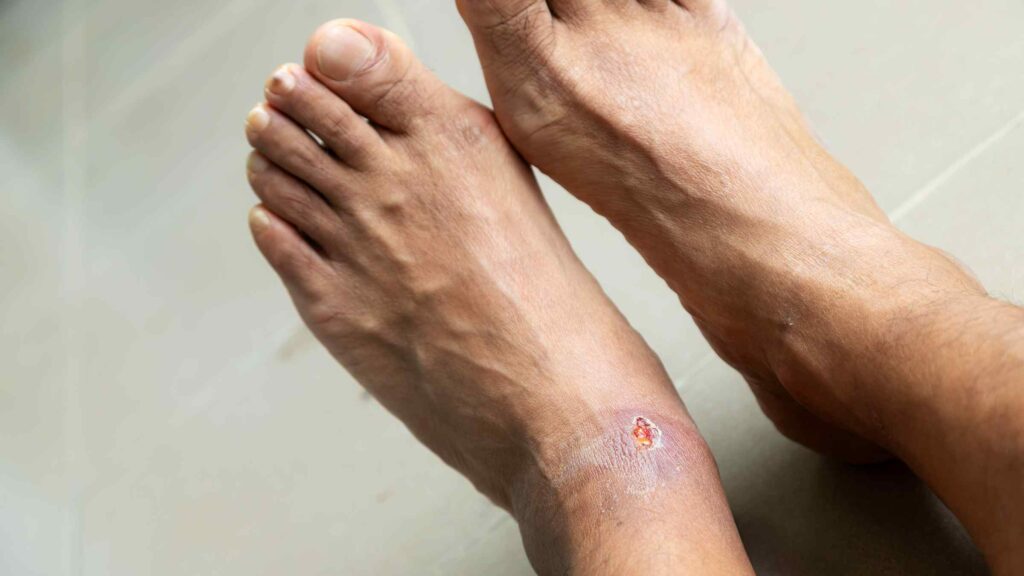Diabetic gangrene is a serious complication that arises when poor blood circulation, often a consequence of diabetes, leads to tissue death. Recognizing and managing this condition is crucial for maintaining quality of life and preventing further complications, including potential amputation. In this guide, we delve into diabetic gangrene treatment options that can help you lead a healthy life.
Contents
What Is Diabetic Gangrene?
 Diabetic gangrene is a severe and potentially life-threatening condition often associated with diabetes, particularly when blood sugar levels are poorly controlled. The term “gangrene” refers to the death of body tissue due to a lack of blood flow or a serious bacterial infection. In individuals with diabetes, this condition primarily arises due to two key factors: nerve damage (neuropathy) and poor circulation.
Diabetic gangrene is a severe and potentially life-threatening condition often associated with diabetes, particularly when blood sugar levels are poorly controlled. The term “gangrene” refers to the death of body tissue due to a lack of blood flow or a serious bacterial infection. In individuals with diabetes, this condition primarily arises due to two key factors: nerve damage (neuropathy) and poor circulation.
Neuropathy, a common complication of diabetes, results in a loss of sensation in the extremities, particularly the feet. This reduced sensation means injuries or infections might go unnoticed and untreated, leading to the development of gangrene. Furthermore, diabetes can lead to the narrowing and hardening of arteries, diminishing blood flow to the extremities. This compromised blood flow makes it difficult for wounds to heal and increases the risk of infection. This can escalate to gangrene.
The condition is characterized by discoloration (often black), severe pain or numbness, and a foul smell in the affected area. Immediate medical attention is crucial for treating diabetic gangrene to prevent its spread and potentially life-threatening complications.
What Is The Best Diabetic Gangrene Treatment?
The best diabetic gangrene treatment typically involves a combination of approaches tailored to the severity and progression of the condition. Here are some key aspects of the treatment:
Blood Sugar Control
Effective management of blood sugar levels is crucial in treating diabetic gangrene. High blood sugar can impair immune function, slow down wound healing, and exacerbate circulatory problems. Patients are advised to adhere strictly to their diabetic medication regimen, and dietary restrictions, and monitor their blood sugar levels regularly.
Antibiotics
If the gangrene is caused or accompanied by an infection, antibiotics are essential. They are selected based on the type of bacteria causing the infection and its sensitivity to different antibiotics. Treatment duration can vary depending on the severity of the infection.
Debridement
This involves the surgical removal of dead or infected tissue to prevent the spread of gangrene. Debridement is a critical step in managing gangrene as it removes the source of infection and allows healthy tissue to heal more effectively.
Revascularization
In cases where poor blood flow has contributed to the development of gangrene, procedures to restore blood flow (revascularization) may be necessary. This can include surgical options like angioplasty or bypass surgery to improve blood supply to the affected area.
Hyperbaric Oxygen Therapy
This therapy involves breathing pure oxygen in a pressurized room or chamber. It helps to increase the amount of oxygen in the blood. This can accelerate wound healing and help fight infection. This therapy is particularly useful for patients with non-healing wounds.
Amputation
In severe cases, where the gangrene is extensive and other treatments are not effective, amputation of the affected limb or part of it may be necessary. This is considered a last resort but can be lifesaving and can prevent the spread of infection to other parts of the body.
Pain Management
Gangrene can be extremely painful. Adequate pain management is crucial for patient comfort. This may involve the use of painkillers, including both over-the-counter and prescription medications, depending on the severity of the pain.
Lifestyle Changes and Foot Care
 For patients with diabetes, regular foot care is essential to prevent gangrene. This includes regular inspection of the feet for cuts, blisters, and sores, wearing appropriate footwear, and avoiding activities that could injure the feet. Additionally, lifestyle changes such as quitting smoking. It can impair circulation, maintaining a healthy diet, and engaging in regular exercise are vital in managing diabetes and preventing complications like gangrene.
For patients with diabetes, regular foot care is essential to prevent gangrene. This includes regular inspection of the feet for cuts, blisters, and sores, wearing appropriate footwear, and avoiding activities that could injure the feet. Additionally, lifestyle changes such as quitting smoking. It can impair circulation, maintaining a healthy diet, and engaging in regular exercise are vital in managing diabetes and preventing complications like gangrene.
It’s important to note that early detection and treatment are critical in managing diabetic gangrene. Regular foot examinations and prompt attention to any signs of foot problems are essential preventive measures for individuals with diabetes. Always consult healthcare professionals for a treatment plan tailored to individual needs and circumstances.
Which Ointment Is Best For Gangrene?
There isn’t a one-size-fits-all answer for the best ointment for treating gangrene, particularly in diabetic patients, as the treatment largely depends on the severity and type of the gangrene. However, we can provide some general information on the types of topical treatments that are commonly used in the management of gangrene:
- Iodine-Based Ointments: Iodine has antiseptic properties and is often used in wound care to prevent and treat infections. Ointments containing iodine can be effective in managing some cases of gangrene. Especially in the early stages or for minor infections.
- Honey-Based Dressings: Medical-grade honey dressings have natural antibacterial properties and have been used in wound care, including for diabetic ulcers that can lead to gangrene. These dressings can help in keeping the wound moist and promote healing.
- Silver-Containing Dressings: Silver has antimicrobial properties and dressings impregnated with silver are sometimes used in the treatment of diabetic foot ulcers to prevent or control infection.
- Pain-Relieving Ointments: If the gangrene is painful, topical analgesics might be used to provide some relief. However, pain relief does not treat the underlying condition of gangrene.
- Hyperbaric Oxygen Therapy: While not an ointment, hyperbaric oxygen therapy is a treatment sometimes used for gangrene. It involves breathing pure oxygen in a pressurized room or chamber. And is believed to help promote healing and fight infection.
Overall, it’s important to note that topical treatments alone are often not sufficient for treating gangrene, especially in advanced cases. The treatment should always be guided by a healthcare professional who can assess the specific needs of the individual patient.
Is Diabetic Gangrene Curable?
 Diabetic gangrene, while a serious and potentially life-threatening condition, is typically not curable in the traditional sense. Once gangrene has developed, it signifies significant tissue damage and necrosis, which cannot be reversed. However, the progression of diabetic gangrene can be halted and managed effectively with prompt and comprehensive medical intervention. Treatment focuses on several key aspects: controlling blood sugar levels to prevent further tissue damage.
Diabetic gangrene, while a serious and potentially life-threatening condition, is typically not curable in the traditional sense. Once gangrene has developed, it signifies significant tissue damage and necrosis, which cannot be reversed. However, the progression of diabetic gangrene can be halted and managed effectively with prompt and comprehensive medical intervention. Treatment focuses on several key aspects: controlling blood sugar levels to prevent further tissue damage.
Moreover, diabetic patients with gangrene require diligent wound care and ongoing management to prevent recurrence and further complications. Despite being incurable in the conventional sense, with timely and appropriate medical care, diabetic gangrene can be effectively managed, allowing individuals to lead fulfilling lives with proper lifestyle adjustments and ongoing healthcare support. Early detection, proactive management of diabetes, and vigilant monitoring of foot health are essential in preventing the development of diabetic gangrene.
Conclusion
In conclusion, diabetic gangrene treatment poses significant challenges and requires comprehensive medical intervention, it is crucial to emphasize that timely detection and proactive management can greatly improve outcomes and quality of life. Through a combination of controlling blood sugar levels, addressing vascular issues, administering appropriate medications, and performing necessary surgical interventions, diabetic gangrene can be effectively managed.
However, prevention remains the best approach, highlighting the importance of regular foot care, monitoring for signs of infection or injury, and maintaining optimal diabetes management. Do you want to get rid of diabetes? Join our online diabetes treatment program and reverse Diabetes naturally through lifestyle changes such as a Personalized Diet plan, Exercise, Yoga, dieticians, and health coaches.

